Critical Commentary: Parent Partnership and Professional Development
VerifiedAdded on 2021/10/03
|25
|7007
|122
Report
AI Summary
This report presents a critical commentary on parent partnership and professional development, exploring their significance in education. It begins by emphasizing the crucial role of parents as a child's first teachers and the importance of collaboration between parents and educators. The report then delves into the concept of professional development for teachers, highlighting its role in adapting to a changing educational landscape and improving teaching practices. It analyzes key components like content focus, collaborative participation, and active learning. The commentary then focuses on parent partnership, examining various models and strategies to enhance parental involvement, including the Epstein and Hoover-Dempsey models, and discussing the different aspects. It also evaluates the potential challenges and benefits of parent-teacher collaboration, offering insights into fostering effective relationships to improve student outcomes. The report provides a comprehensive overview of the topic, providing insights into the benefits of parent involvement in education.
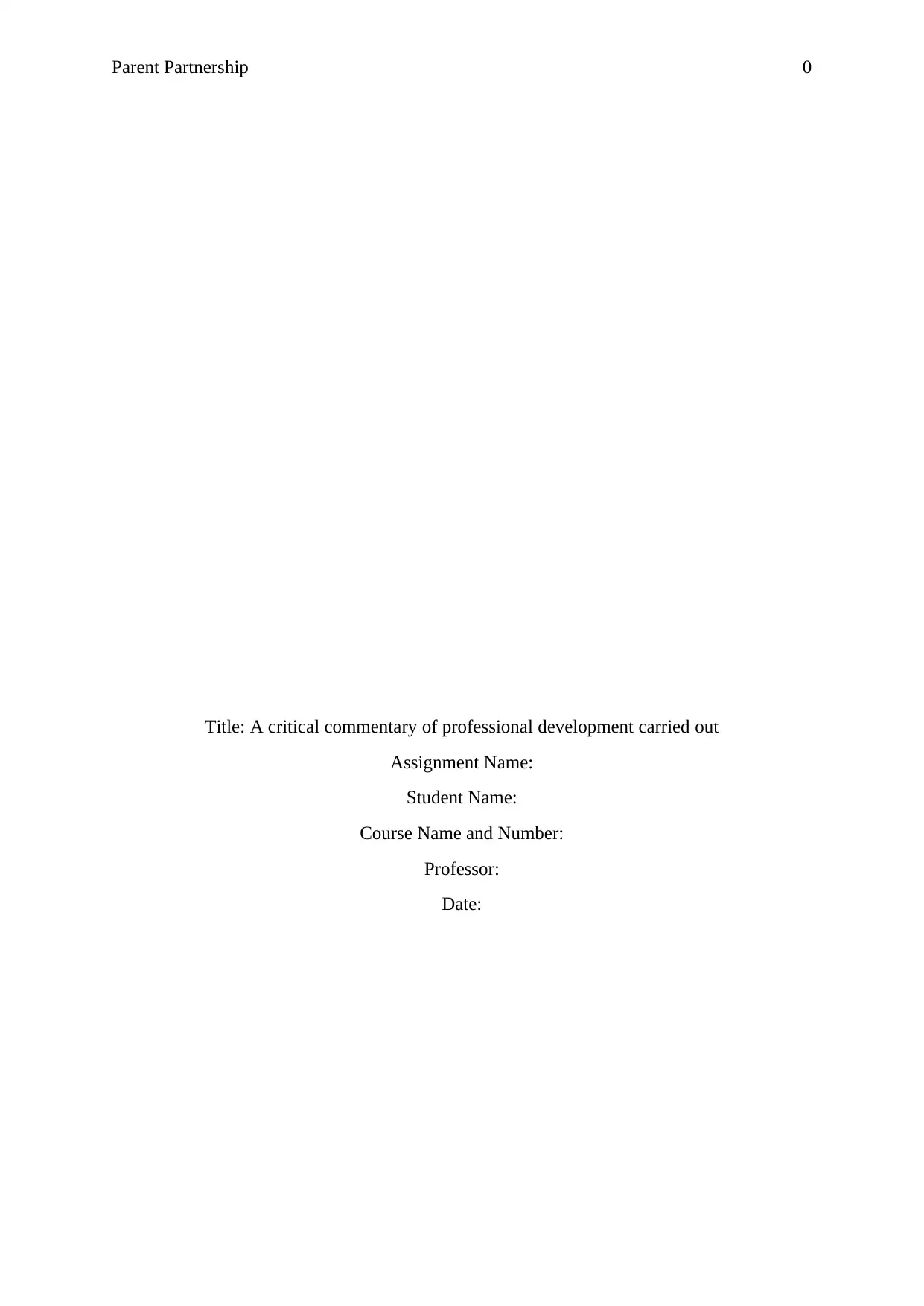
Parent Partnership 0
Title: A critical commentary of professional development carried out
Assignment Name:
Student Name:
Course Name and Number:
Professor:
Date:
Title: A critical commentary of professional development carried out
Assignment Name:
Student Name:
Course Name and Number:
Professor:
Date:
Paraphrase This Document
Need a fresh take? Get an instant paraphrase of this document with our AI Paraphraser
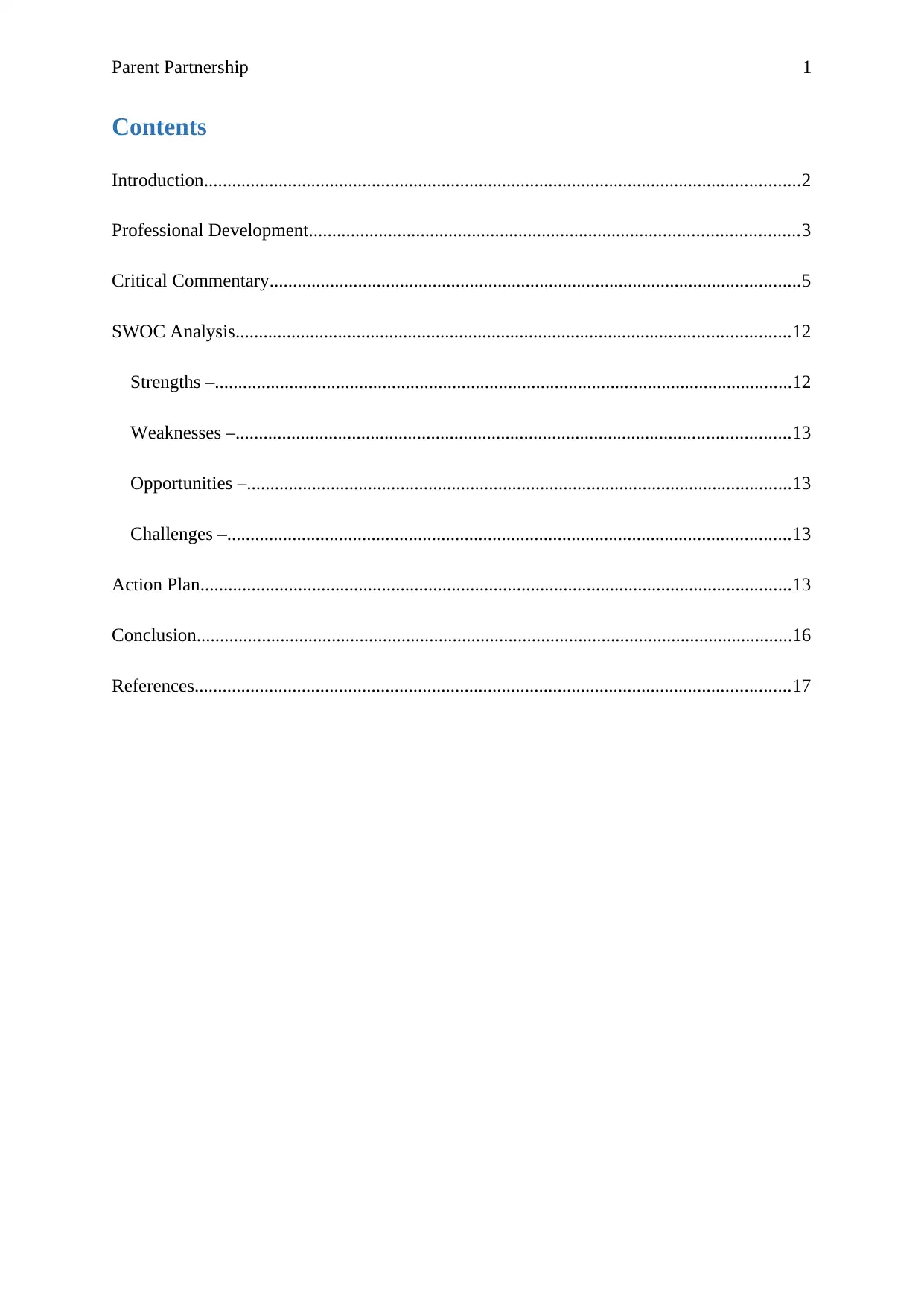
Parent Partnership 1
Contents
Introduction................................................................................................................................2
Professional Development.........................................................................................................3
Critical Commentary..................................................................................................................5
SWOC Analysis.......................................................................................................................12
Strengths –............................................................................................................................12
Weaknesses –.......................................................................................................................13
Opportunities –.....................................................................................................................13
Challenges –.........................................................................................................................13
Action Plan...............................................................................................................................13
Conclusion................................................................................................................................16
References................................................................................................................................17
Contents
Introduction................................................................................................................................2
Professional Development.........................................................................................................3
Critical Commentary..................................................................................................................5
SWOC Analysis.......................................................................................................................12
Strengths –............................................................................................................................12
Weaknesses –.......................................................................................................................13
Opportunities –.....................................................................................................................13
Challenges –.........................................................................................................................13
Action Plan...............................................................................................................................13
Conclusion................................................................................................................................16
References................................................................................................................................17
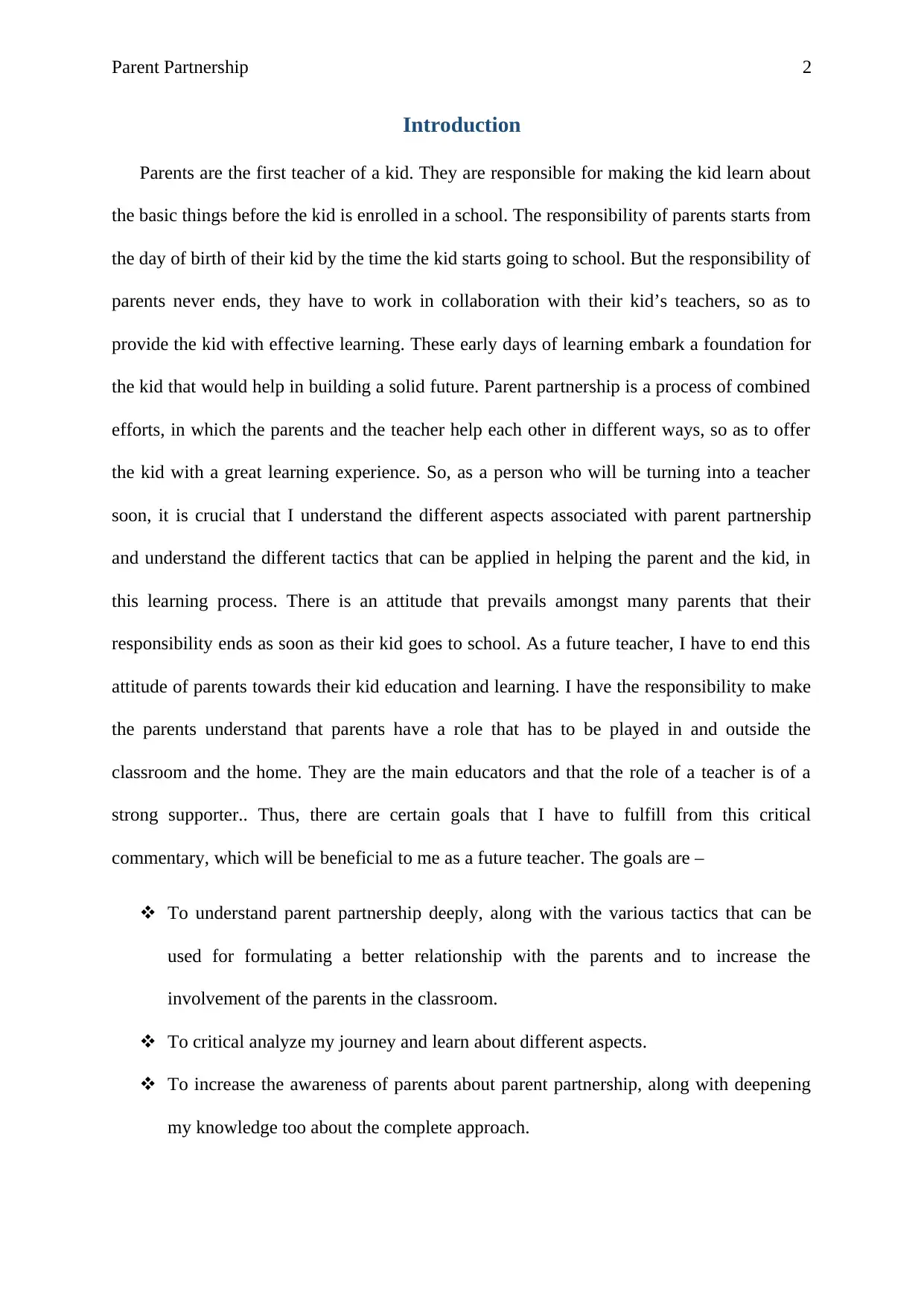
Parent Partnership 2
Introduction
Parents are the first teacher of a kid. They are responsible for making the kid learn about
the basic things before the kid is enrolled in a school. The responsibility of parents starts from
the day of birth of their kid by the time the kid starts going to school. But the responsibility of
parents never ends, they have to work in collaboration with their kid’s teachers, so as to
provide the kid with effective learning. These early days of learning embark a foundation for
the kid that would help in building a solid future. Parent partnership is a process of combined
efforts, in which the parents and the teacher help each other in different ways, so as to offer
the kid with a great learning experience. So, as a person who will be turning into a teacher
soon, it is crucial that I understand the different aspects associated with parent partnership
and understand the different tactics that can be applied in helping the parent and the kid, in
this learning process. There is an attitude that prevails amongst many parents that their
responsibility ends as soon as their kid goes to school. As a future teacher, I have to end this
attitude of parents towards their kid education and learning. I have the responsibility to make
the parents understand that parents have a role that has to be played in and outside the
classroom and the home. They are the main educators and that the role of a teacher is of a
strong supporter.. Thus, there are certain goals that I have to fulfill from this critical
commentary, which will be beneficial to me as a future teacher. The goals are –
To understand parent partnership deeply, along with the various tactics that can be
used for formulating a better relationship with the parents and to increase the
involvement of the parents in the classroom.
To critical analyze my journey and learn about different aspects.
To increase the awareness of parents about parent partnership, along with deepening
my knowledge too about the complete approach.
Introduction
Parents are the first teacher of a kid. They are responsible for making the kid learn about
the basic things before the kid is enrolled in a school. The responsibility of parents starts from
the day of birth of their kid by the time the kid starts going to school. But the responsibility of
parents never ends, they have to work in collaboration with their kid’s teachers, so as to
provide the kid with effective learning. These early days of learning embark a foundation for
the kid that would help in building a solid future. Parent partnership is a process of combined
efforts, in which the parents and the teacher help each other in different ways, so as to offer
the kid with a great learning experience. So, as a person who will be turning into a teacher
soon, it is crucial that I understand the different aspects associated with parent partnership
and understand the different tactics that can be applied in helping the parent and the kid, in
this learning process. There is an attitude that prevails amongst many parents that their
responsibility ends as soon as their kid goes to school. As a future teacher, I have to end this
attitude of parents towards their kid education and learning. I have the responsibility to make
the parents understand that parents have a role that has to be played in and outside the
classroom and the home. They are the main educators and that the role of a teacher is of a
strong supporter.. Thus, there are certain goals that I have to fulfill from this critical
commentary, which will be beneficial to me as a future teacher. The goals are –
To understand parent partnership deeply, along with the various tactics that can be
used for formulating a better relationship with the parents and to increase the
involvement of the parents in the classroom.
To critical analyze my journey and learn about different aspects.
To increase the awareness of parents about parent partnership, along with deepening
my knowledge too about the complete approach.
⊘ This is a preview!⊘
Do you want full access?
Subscribe today to unlock all pages.

Trusted by 1+ million students worldwide
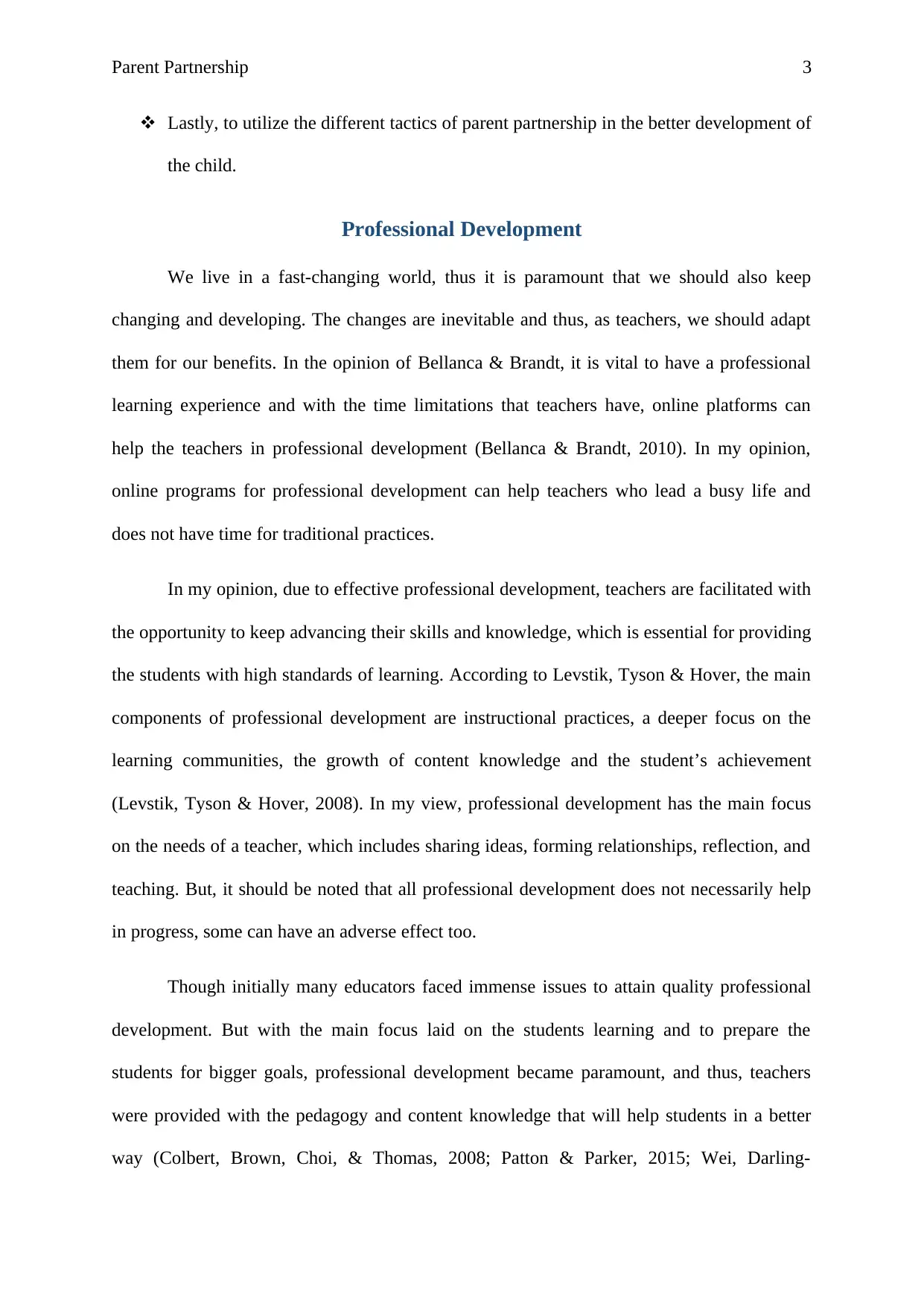
Parent Partnership 3
Lastly, to utilize the different tactics of parent partnership in the better development of
the child.
Professional Development
We live in a fast-changing world, thus it is paramount that we should also keep
changing and developing. The changes are inevitable and thus, as teachers, we should adapt
them for our benefits. In the opinion of Bellanca & Brandt, it is vital to have a professional
learning experience and with the time limitations that teachers have, online platforms can
help the teachers in professional development (Bellanca & Brandt, 2010). In my opinion,
online programs for professional development can help teachers who lead a busy life and
does not have time for traditional practices.
In my opinion, due to effective professional development, teachers are facilitated with
the opportunity to keep advancing their skills and knowledge, which is essential for providing
the students with high standards of learning. According to Levstik, Tyson & Hover, the main
components of professional development are instructional practices, a deeper focus on the
learning communities, the growth of content knowledge and the student’s achievement
(Levstik, Tyson & Hover, 2008). In my view, professional development has the main focus
on the needs of a teacher, which includes sharing ideas, forming relationships, reflection, and
teaching. But, it should be noted that all professional development does not necessarily help
in progress, some can have an adverse effect too.
Though initially many educators faced immense issues to attain quality professional
development. But with the main focus laid on the students learning and to prepare the
students for bigger goals, professional development became paramount, and thus, teachers
were provided with the pedagogy and content knowledge that will help students in a better
way (Colbert, Brown, Choi, & Thomas, 2008; Patton & Parker, 2015; Wei, Darling-
Lastly, to utilize the different tactics of parent partnership in the better development of
the child.
Professional Development
We live in a fast-changing world, thus it is paramount that we should also keep
changing and developing. The changes are inevitable and thus, as teachers, we should adapt
them for our benefits. In the opinion of Bellanca & Brandt, it is vital to have a professional
learning experience and with the time limitations that teachers have, online platforms can
help the teachers in professional development (Bellanca & Brandt, 2010). In my opinion,
online programs for professional development can help teachers who lead a busy life and
does not have time for traditional practices.
In my opinion, due to effective professional development, teachers are facilitated with
the opportunity to keep advancing their skills and knowledge, which is essential for providing
the students with high standards of learning. According to Levstik, Tyson & Hover, the main
components of professional development are instructional practices, a deeper focus on the
learning communities, the growth of content knowledge and the student’s achievement
(Levstik, Tyson & Hover, 2008). In my view, professional development has the main focus
on the needs of a teacher, which includes sharing ideas, forming relationships, reflection, and
teaching. But, it should be noted that all professional development does not necessarily help
in progress, some can have an adverse effect too.
Though initially many educators faced immense issues to attain quality professional
development. But with the main focus laid on the students learning and to prepare the
students for bigger goals, professional development became paramount, and thus, teachers
were provided with the pedagogy and content knowledge that will help students in a better
way (Colbert, Brown, Choi, & Thomas, 2008; Patton & Parker, 2015; Wei, Darling-
Paraphrase This Document
Need a fresh take? Get an instant paraphrase of this document with our AI Paraphraser
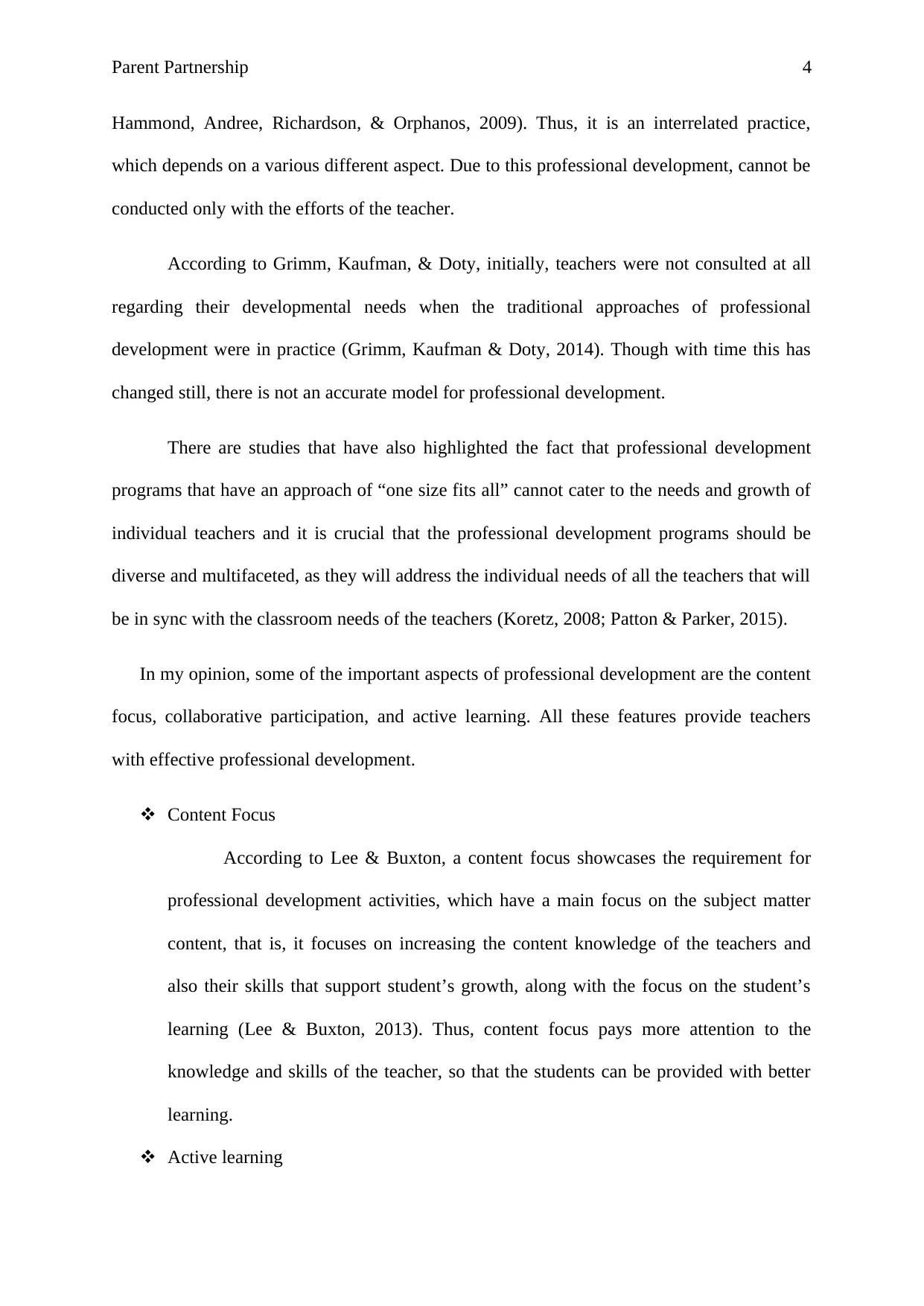
Parent Partnership 4
Hammond, Andree, Richardson, & Orphanos, 2009). Thus, it is an interrelated practice,
which depends on a various different aspect. Due to this professional development, cannot be
conducted only with the efforts of the teacher.
According to Grimm, Kaufman, & Doty, initially, teachers were not consulted at all
regarding their developmental needs when the traditional approaches of professional
development were in practice (Grimm, Kaufman & Doty, 2014). Though with time this has
changed still, there is not an accurate model for professional development.
There are studies that have also highlighted the fact that professional development
programs that have an approach of “one size fits all” cannot cater to the needs and growth of
individual teachers and it is crucial that the professional development programs should be
diverse and multifaceted, as they will address the individual needs of all the teachers that will
be in sync with the classroom needs of the teachers (Koretz, 2008; Patton & Parker, 2015).
In my opinion, some of the important aspects of professional development are the content
focus, collaborative participation, and active learning. All these features provide teachers
with effective professional development.
Content Focus
According to Lee & Buxton, a content focus showcases the requirement for
professional development activities, which have a main focus on the subject matter
content, that is, it focuses on increasing the content knowledge of the teachers and
also their skills that support student’s growth, along with the focus on the student’s
learning (Lee & Buxton, 2013). Thus, content focus pays more attention to the
knowledge and skills of the teacher, so that the students can be provided with better
learning.
Active learning
Hammond, Andree, Richardson, & Orphanos, 2009). Thus, it is an interrelated practice,
which depends on a various different aspect. Due to this professional development, cannot be
conducted only with the efforts of the teacher.
According to Grimm, Kaufman, & Doty, initially, teachers were not consulted at all
regarding their developmental needs when the traditional approaches of professional
development were in practice (Grimm, Kaufman & Doty, 2014). Though with time this has
changed still, there is not an accurate model for professional development.
There are studies that have also highlighted the fact that professional development
programs that have an approach of “one size fits all” cannot cater to the needs and growth of
individual teachers and it is crucial that the professional development programs should be
diverse and multifaceted, as they will address the individual needs of all the teachers that will
be in sync with the classroom needs of the teachers (Koretz, 2008; Patton & Parker, 2015).
In my opinion, some of the important aspects of professional development are the content
focus, collaborative participation, and active learning. All these features provide teachers
with effective professional development.
Content Focus
According to Lee & Buxton, a content focus showcases the requirement for
professional development activities, which have a main focus on the subject matter
content, that is, it focuses on increasing the content knowledge of the teachers and
also their skills that support student’s growth, along with the focus on the student’s
learning (Lee & Buxton, 2013). Thus, content focus pays more attention to the
knowledge and skills of the teacher, so that the students can be provided with better
learning.
Active learning
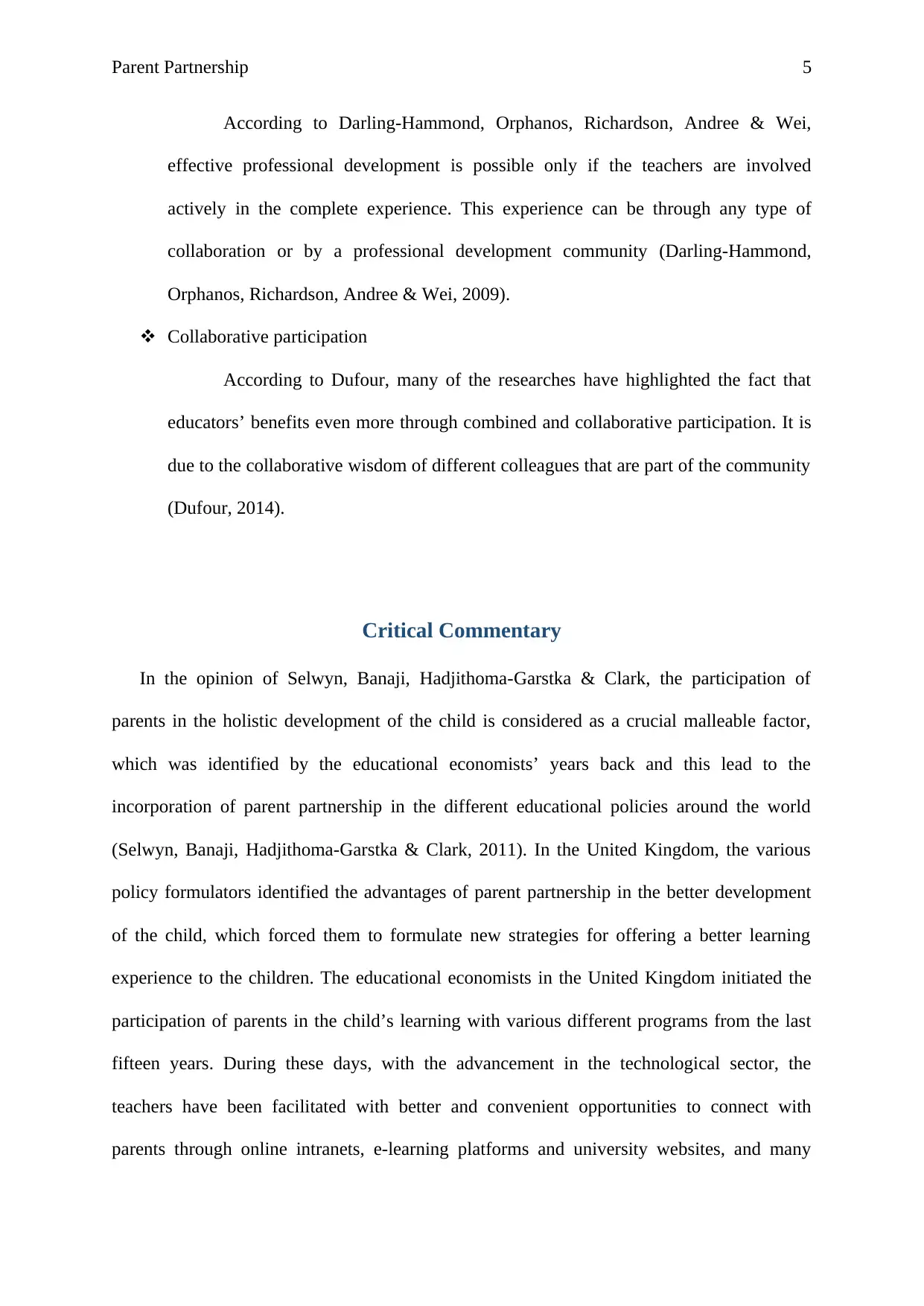
Parent Partnership 5
According to Darling-Hammond, Orphanos, Richardson, Andree & Wei,
effective professional development is possible only if the teachers are involved
actively in the complete experience. This experience can be through any type of
collaboration or by a professional development community (Darling-Hammond,
Orphanos, Richardson, Andree & Wei, 2009).
Collaborative participation
According to Dufour, many of the researches have highlighted the fact that
educators’ benefits even more through combined and collaborative participation. It is
due to the collaborative wisdom of different colleagues that are part of the community
(Dufour, 2014).
Critical Commentary
In the opinion of Selwyn, Banaji, Hadjithoma-Garstka & Clark, the participation of
parents in the holistic development of the child is considered as a crucial malleable factor,
which was identified by the educational economists’ years back and this lead to the
incorporation of parent partnership in the different educational policies around the world
(Selwyn, Banaji, Hadjithoma-Garstka & Clark, 2011). In the United Kingdom, the various
policy formulators identified the advantages of parent partnership in the better development
of the child, which forced them to formulate new strategies for offering a better learning
experience to the children. The educational economists in the United Kingdom initiated the
participation of parents in the child’s learning with various different programs from the last
fifteen years. During these days, with the advancement in the technological sector, the
teachers have been facilitated with better and convenient opportunities to connect with
parents through online intranets, e-learning platforms and university websites, and many
According to Darling-Hammond, Orphanos, Richardson, Andree & Wei,
effective professional development is possible only if the teachers are involved
actively in the complete experience. This experience can be through any type of
collaboration or by a professional development community (Darling-Hammond,
Orphanos, Richardson, Andree & Wei, 2009).
Collaborative participation
According to Dufour, many of the researches have highlighted the fact that
educators’ benefits even more through combined and collaborative participation. It is
due to the collaborative wisdom of different colleagues that are part of the community
(Dufour, 2014).
Critical Commentary
In the opinion of Selwyn, Banaji, Hadjithoma-Garstka & Clark, the participation of
parents in the holistic development of the child is considered as a crucial malleable factor,
which was identified by the educational economists’ years back and this lead to the
incorporation of parent partnership in the different educational policies around the world
(Selwyn, Banaji, Hadjithoma-Garstka & Clark, 2011). In the United Kingdom, the various
policy formulators identified the advantages of parent partnership in the better development
of the child, which forced them to formulate new strategies for offering a better learning
experience to the children. The educational economists in the United Kingdom initiated the
participation of parents in the child’s learning with various different programs from the last
fifteen years. During these days, with the advancement in the technological sector, the
teachers have been facilitated with better and convenient opportunities to connect with
parents through online intranets, e-learning platforms and university websites, and many
⊘ This is a preview!⊘
Do you want full access?
Subscribe today to unlock all pages.

Trusted by 1+ million students worldwide
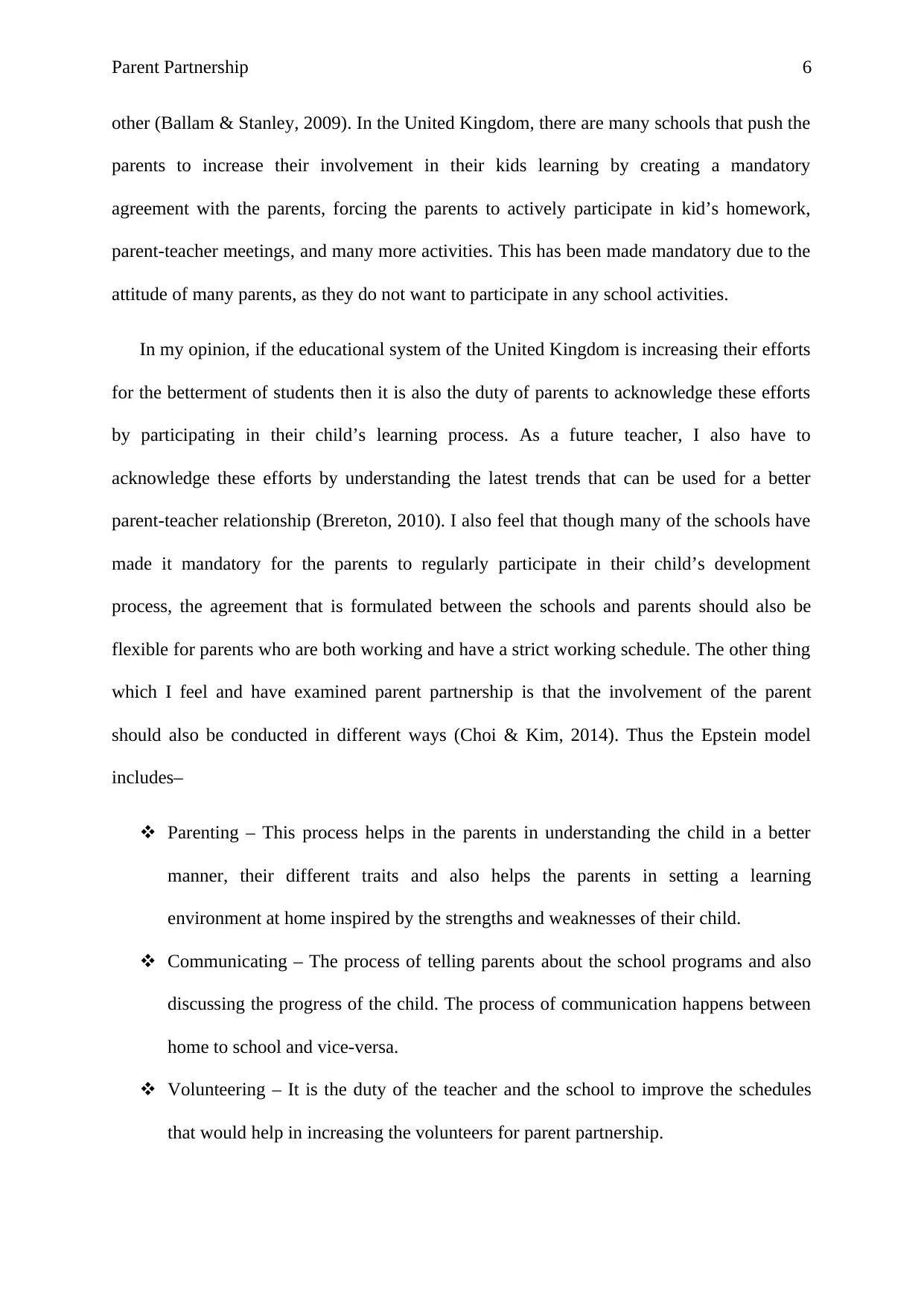
Parent Partnership 6
other (Ballam & Stanley, 2009). In the United Kingdom, there are many schools that push the
parents to increase their involvement in their kids learning by creating a mandatory
agreement with the parents, forcing the parents to actively participate in kid’s homework,
parent-teacher meetings, and many more activities. This has been made mandatory due to the
attitude of many parents, as they do not want to participate in any school activities.
In my opinion, if the educational system of the United Kingdom is increasing their efforts
for the betterment of students then it is also the duty of parents to acknowledge these efforts
by participating in their child’s learning process. As a future teacher, I also have to
acknowledge these efforts by understanding the latest trends that can be used for a better
parent-teacher relationship (Brereton, 2010). I also feel that though many of the schools have
made it mandatory for the parents to regularly participate in their child’s development
process, the agreement that is formulated between the schools and parents should also be
flexible for parents who are both working and have a strict working schedule. The other thing
which I feel and have examined parent partnership is that the involvement of the parent
should also be conducted in different ways (Choi & Kim, 2014). Thus the Epstein model
includes–
Parenting – This process helps in the parents in understanding the child in a better
manner, their different traits and also helps the parents in setting a learning
environment at home inspired by the strengths and weaknesses of their child.
Communicating – The process of telling parents about the school programs and also
discussing the progress of the child. The process of communication happens between
home to school and vice-versa.
Volunteering – It is the duty of the teacher and the school to improve the schedules
that would help in increasing the volunteers for parent partnership.
other (Ballam & Stanley, 2009). In the United Kingdom, there are many schools that push the
parents to increase their involvement in their kids learning by creating a mandatory
agreement with the parents, forcing the parents to actively participate in kid’s homework,
parent-teacher meetings, and many more activities. This has been made mandatory due to the
attitude of many parents, as they do not want to participate in any school activities.
In my opinion, if the educational system of the United Kingdom is increasing their efforts
for the betterment of students then it is also the duty of parents to acknowledge these efforts
by participating in their child’s learning process. As a future teacher, I also have to
acknowledge these efforts by understanding the latest trends that can be used for a better
parent-teacher relationship (Brereton, 2010). I also feel that though many of the schools have
made it mandatory for the parents to regularly participate in their child’s development
process, the agreement that is formulated between the schools and parents should also be
flexible for parents who are both working and have a strict working schedule. The other thing
which I feel and have examined parent partnership is that the involvement of the parent
should also be conducted in different ways (Choi & Kim, 2014). Thus the Epstein model
includes–
Parenting – This process helps in the parents in understanding the child in a better
manner, their different traits and also helps the parents in setting a learning
environment at home inspired by the strengths and weaknesses of their child.
Communicating – The process of telling parents about the school programs and also
discussing the progress of the child. The process of communication happens between
home to school and vice-versa.
Volunteering – It is the duty of the teacher and the school to improve the schedules
that would help in increasing the volunteers for parent partnership.
Paraphrase This Document
Need a fresh take? Get an instant paraphrase of this document with our AI Paraphraser
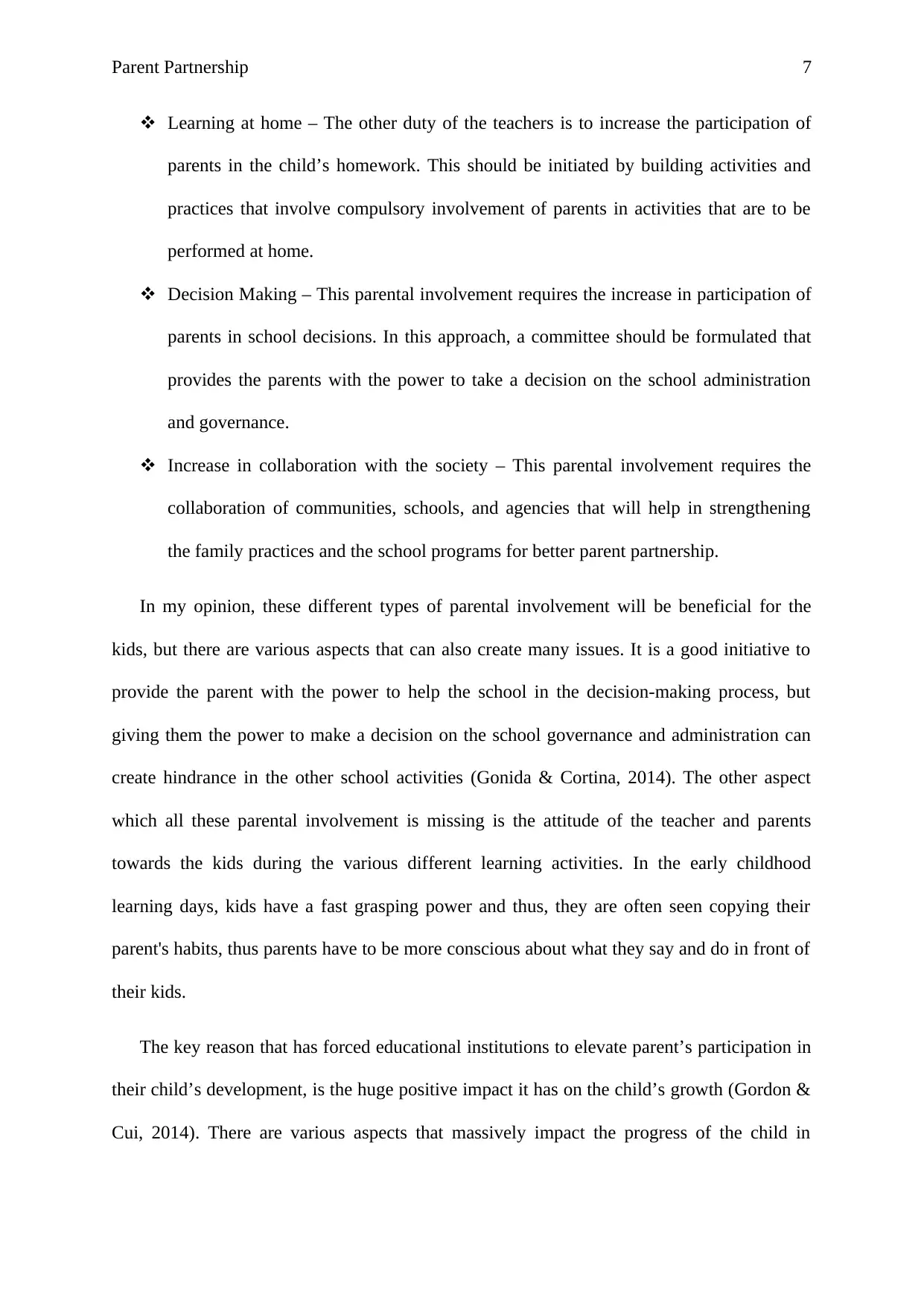
Parent Partnership 7
Learning at home – The other duty of the teachers is to increase the participation of
parents in the child’s homework. This should be initiated by building activities and
practices that involve compulsory involvement of parents in activities that are to be
performed at home.
Decision Making – This parental involvement requires the increase in participation of
parents in school decisions. In this approach, a committee should be formulated that
provides the parents with the power to take a decision on the school administration
and governance.
Increase in collaboration with the society – This parental involvement requires the
collaboration of communities, schools, and agencies that will help in strengthening
the family practices and the school programs for better parent partnership.
In my opinion, these different types of parental involvement will be beneficial for the
kids, but there are various aspects that can also create many issues. It is a good initiative to
provide the parent with the power to help the school in the decision-making process, but
giving them the power to make a decision on the school governance and administration can
create hindrance in the other school activities (Gonida & Cortina, 2014). The other aspect
which all these parental involvement is missing is the attitude of the teacher and parents
towards the kids during the various different learning activities. In the early childhood
learning days, kids have a fast grasping power and thus, they are often seen copying their
parent's habits, thus parents have to be more conscious about what they say and do in front of
their kids.
The key reason that has forced educational institutions to elevate parent’s participation in
their child’s development, is the huge positive impact it has on the child’s growth (Gordon &
Cui, 2014). There are various aspects that massively impact the progress of the child in
Learning at home – The other duty of the teachers is to increase the participation of
parents in the child’s homework. This should be initiated by building activities and
practices that involve compulsory involvement of parents in activities that are to be
performed at home.
Decision Making – This parental involvement requires the increase in participation of
parents in school decisions. In this approach, a committee should be formulated that
provides the parents with the power to take a decision on the school administration
and governance.
Increase in collaboration with the society – This parental involvement requires the
collaboration of communities, schools, and agencies that will help in strengthening
the family practices and the school programs for better parent partnership.
In my opinion, these different types of parental involvement will be beneficial for the
kids, but there are various aspects that can also create many issues. It is a good initiative to
provide the parent with the power to help the school in the decision-making process, but
giving them the power to make a decision on the school governance and administration can
create hindrance in the other school activities (Gonida & Cortina, 2014). The other aspect
which all these parental involvement is missing is the attitude of the teacher and parents
towards the kids during the various different learning activities. In the early childhood
learning days, kids have a fast grasping power and thus, they are often seen copying their
parent's habits, thus parents have to be more conscious about what they say and do in front of
their kids.
The key reason that has forced educational institutions to elevate parent’s participation in
their child’s development, is the huge positive impact it has on the child’s growth (Gordon &
Cui, 2014). There are various aspects that massively impact the progress of the child in
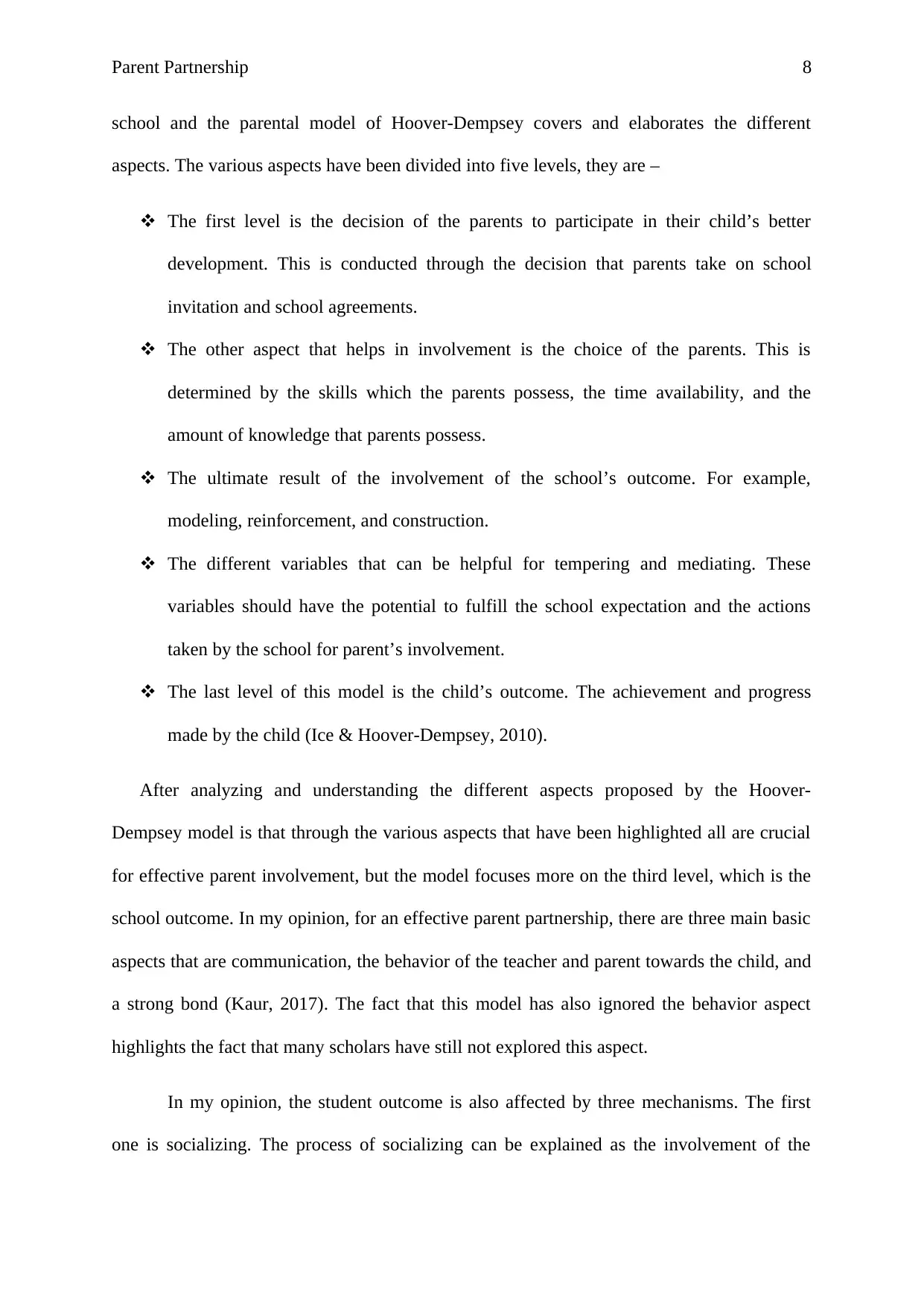
Parent Partnership 8
school and the parental model of Hoover-Dempsey covers and elaborates the different
aspects. The various aspects have been divided into five levels, they are –
The first level is the decision of the parents to participate in their child’s better
development. This is conducted through the decision that parents take on school
invitation and school agreements.
The other aspect that helps in involvement is the choice of the parents. This is
determined by the skills which the parents possess, the time availability, and the
amount of knowledge that parents possess.
The ultimate result of the involvement of the school’s outcome. For example,
modeling, reinforcement, and construction.
The different variables that can be helpful for tempering and mediating. These
variables should have the potential to fulfill the school expectation and the actions
taken by the school for parent’s involvement.
The last level of this model is the child’s outcome. The achievement and progress
made by the child (Ice & Hoover-Dempsey, 2010).
After analyzing and understanding the different aspects proposed by the Hoover-
Dempsey model is that through the various aspects that have been highlighted all are crucial
for effective parent involvement, but the model focuses more on the third level, which is the
school outcome. In my opinion, for an effective parent partnership, there are three main basic
aspects that are communication, the behavior of the teacher and parent towards the child, and
a strong bond (Kaur, 2017). The fact that this model has also ignored the behavior aspect
highlights the fact that many scholars have still not explored this aspect.
In my opinion, the student outcome is also affected by three mechanisms. The first
one is socializing. The process of socializing can be explained as the involvement of the
school and the parental model of Hoover-Dempsey covers and elaborates the different
aspects. The various aspects have been divided into five levels, they are –
The first level is the decision of the parents to participate in their child’s better
development. This is conducted through the decision that parents take on school
invitation and school agreements.
The other aspect that helps in involvement is the choice of the parents. This is
determined by the skills which the parents possess, the time availability, and the
amount of knowledge that parents possess.
The ultimate result of the involvement of the school’s outcome. For example,
modeling, reinforcement, and construction.
The different variables that can be helpful for tempering and mediating. These
variables should have the potential to fulfill the school expectation and the actions
taken by the school for parent’s involvement.
The last level of this model is the child’s outcome. The achievement and progress
made by the child (Ice & Hoover-Dempsey, 2010).
After analyzing and understanding the different aspects proposed by the Hoover-
Dempsey model is that through the various aspects that have been highlighted all are crucial
for effective parent involvement, but the model focuses more on the third level, which is the
school outcome. In my opinion, for an effective parent partnership, there are three main basic
aspects that are communication, the behavior of the teacher and parent towards the child, and
a strong bond (Kaur, 2017). The fact that this model has also ignored the behavior aspect
highlights the fact that many scholars have still not explored this aspect.
In my opinion, the student outcome is also affected by three mechanisms. The first
one is socializing. The process of socializing can be explained as the involvement of the
⊘ This is a preview!⊘
Do you want full access?
Subscribe today to unlock all pages.

Trusted by 1+ million students worldwide
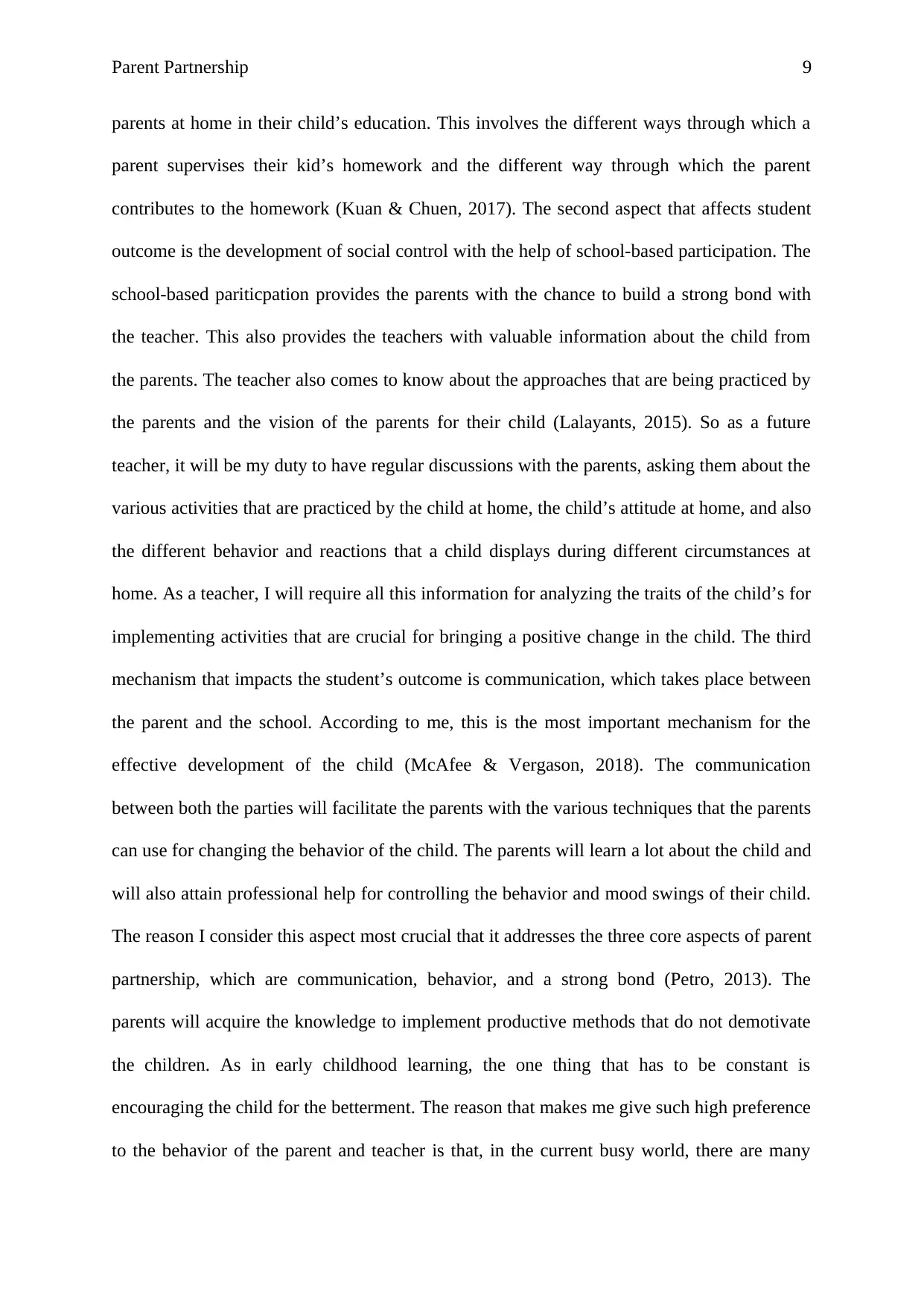
Parent Partnership 9
parents at home in their child’s education. This involves the different ways through which a
parent supervises their kid’s homework and the different way through which the parent
contributes to the homework (Kuan & Chuen, 2017). The second aspect that affects student
outcome is the development of social control with the help of school-based participation. The
school-based pariticpation provides the parents with the chance to build a strong bond with
the teacher. This also provides the teachers with valuable information about the child from
the parents. The teacher also comes to know about the approaches that are being practiced by
the parents and the vision of the parents for their child (Lalayants, 2015). So as a future
teacher, it will be my duty to have regular discussions with the parents, asking them about the
various activities that are practiced by the child at home, the child’s attitude at home, and also
the different behavior and reactions that a child displays during different circumstances at
home. As a teacher, I will require all this information for analyzing the traits of the child’s for
implementing activities that are crucial for bringing a positive change in the child. The third
mechanism that impacts the student’s outcome is communication, which takes place between
the parent and the school. According to me, this is the most important mechanism for the
effective development of the child (McAfee & Vergason, 2018). The communication
between both the parties will facilitate the parents with the various techniques that the parents
can use for changing the behavior of the child. The parents will learn a lot about the child and
will also attain professional help for controlling the behavior and mood swings of their child.
The reason I consider this aspect most crucial that it addresses the three core aspects of parent
partnership, which are communication, behavior, and a strong bond (Petro, 2013). The
parents will acquire the knowledge to implement productive methods that do not demotivate
the children. As in early childhood learning, the one thing that has to be constant is
encouraging the child for the betterment. The reason that makes me give such high preference
to the behavior of the parent and teacher is that, in the current busy world, there are many
parents at home in their child’s education. This involves the different ways through which a
parent supervises their kid’s homework and the different way through which the parent
contributes to the homework (Kuan & Chuen, 2017). The second aspect that affects student
outcome is the development of social control with the help of school-based participation. The
school-based pariticpation provides the parents with the chance to build a strong bond with
the teacher. This also provides the teachers with valuable information about the child from
the parents. The teacher also comes to know about the approaches that are being practiced by
the parents and the vision of the parents for their child (Lalayants, 2015). So as a future
teacher, it will be my duty to have regular discussions with the parents, asking them about the
various activities that are practiced by the child at home, the child’s attitude at home, and also
the different behavior and reactions that a child displays during different circumstances at
home. As a teacher, I will require all this information for analyzing the traits of the child’s for
implementing activities that are crucial for bringing a positive change in the child. The third
mechanism that impacts the student’s outcome is communication, which takes place between
the parent and the school. According to me, this is the most important mechanism for the
effective development of the child (McAfee & Vergason, 2018). The communication
between both the parties will facilitate the parents with the various techniques that the parents
can use for changing the behavior of the child. The parents will learn a lot about the child and
will also attain professional help for controlling the behavior and mood swings of their child.
The reason I consider this aspect most crucial that it addresses the three core aspects of parent
partnership, which are communication, behavior, and a strong bond (Petro, 2013). The
parents will acquire the knowledge to implement productive methods that do not demotivate
the children. As in early childhood learning, the one thing that has to be constant is
encouraging the child for the betterment. The reason that makes me give such high preference
to the behavior of the parent and teacher is that, in the current busy world, there are many
Paraphrase This Document
Need a fresh take? Get an instant paraphrase of this document with our AI Paraphraser
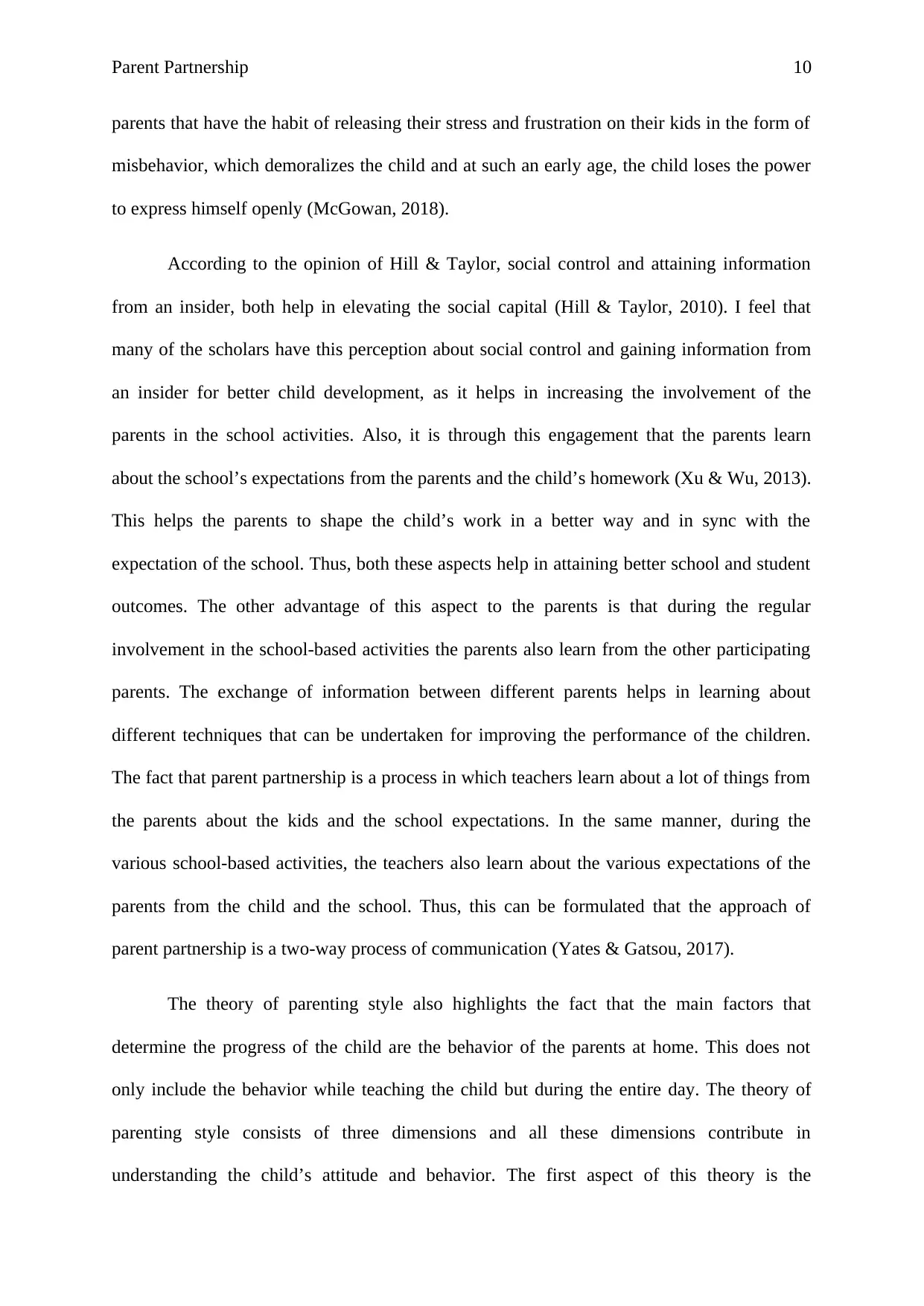
Parent Partnership 10
parents that have the habit of releasing their stress and frustration on their kids in the form of
misbehavior, which demoralizes the child and at such an early age, the child loses the power
to express himself openly (McGowan, 2018).
According to the opinion of Hill & Taylor, social control and attaining information
from an insider, both help in elevating the social capital (Hill & Taylor, 2010). I feel that
many of the scholars have this perception about social control and gaining information from
an insider for better child development, as it helps in increasing the involvement of the
parents in the school activities. Also, it is through this engagement that the parents learn
about the school’s expectations from the parents and the child’s homework (Xu & Wu, 2013).
This helps the parents to shape the child’s work in a better way and in sync with the
expectation of the school. Thus, both these aspects help in attaining better school and student
outcomes. The other advantage of this aspect to the parents is that during the regular
involvement in the school-based activities the parents also learn from the other participating
parents. The exchange of information between different parents helps in learning about
different techniques that can be undertaken for improving the performance of the children.
The fact that parent partnership is a process in which teachers learn about a lot of things from
the parents about the kids and the school expectations. In the same manner, during the
various school-based activities, the teachers also learn about the various expectations of the
parents from the child and the school. Thus, this can be formulated that the approach of
parent partnership is a two-way process of communication (Yates & Gatsou, 2017).
The theory of parenting style also highlights the fact that the main factors that
determine the progress of the child are the behavior of the parents at home. This does not
only include the behavior while teaching the child but during the entire day. The theory of
parenting style consists of three dimensions and all these dimensions contribute in
understanding the child’s attitude and behavior. The first aspect of this theory is the
parents that have the habit of releasing their stress and frustration on their kids in the form of
misbehavior, which demoralizes the child and at such an early age, the child loses the power
to express himself openly (McGowan, 2018).
According to the opinion of Hill & Taylor, social control and attaining information
from an insider, both help in elevating the social capital (Hill & Taylor, 2010). I feel that
many of the scholars have this perception about social control and gaining information from
an insider for better child development, as it helps in increasing the involvement of the
parents in the school activities. Also, it is through this engagement that the parents learn
about the school’s expectations from the parents and the child’s homework (Xu & Wu, 2013).
This helps the parents to shape the child’s work in a better way and in sync with the
expectation of the school. Thus, both these aspects help in attaining better school and student
outcomes. The other advantage of this aspect to the parents is that during the regular
involvement in the school-based activities the parents also learn from the other participating
parents. The exchange of information between different parents helps in learning about
different techniques that can be undertaken for improving the performance of the children.
The fact that parent partnership is a process in which teachers learn about a lot of things from
the parents about the kids and the school expectations. In the same manner, during the
various school-based activities, the teachers also learn about the various expectations of the
parents from the child and the school. Thus, this can be formulated that the approach of
parent partnership is a two-way process of communication (Yates & Gatsou, 2017).
The theory of parenting style also highlights the fact that the main factors that
determine the progress of the child are the behavior of the parents at home. This does not
only include the behavior while teaching the child but during the entire day. The theory of
parenting style consists of three dimensions and all these dimensions contribute in
understanding the child’s attitude and behavior. The first aspect of this theory is the
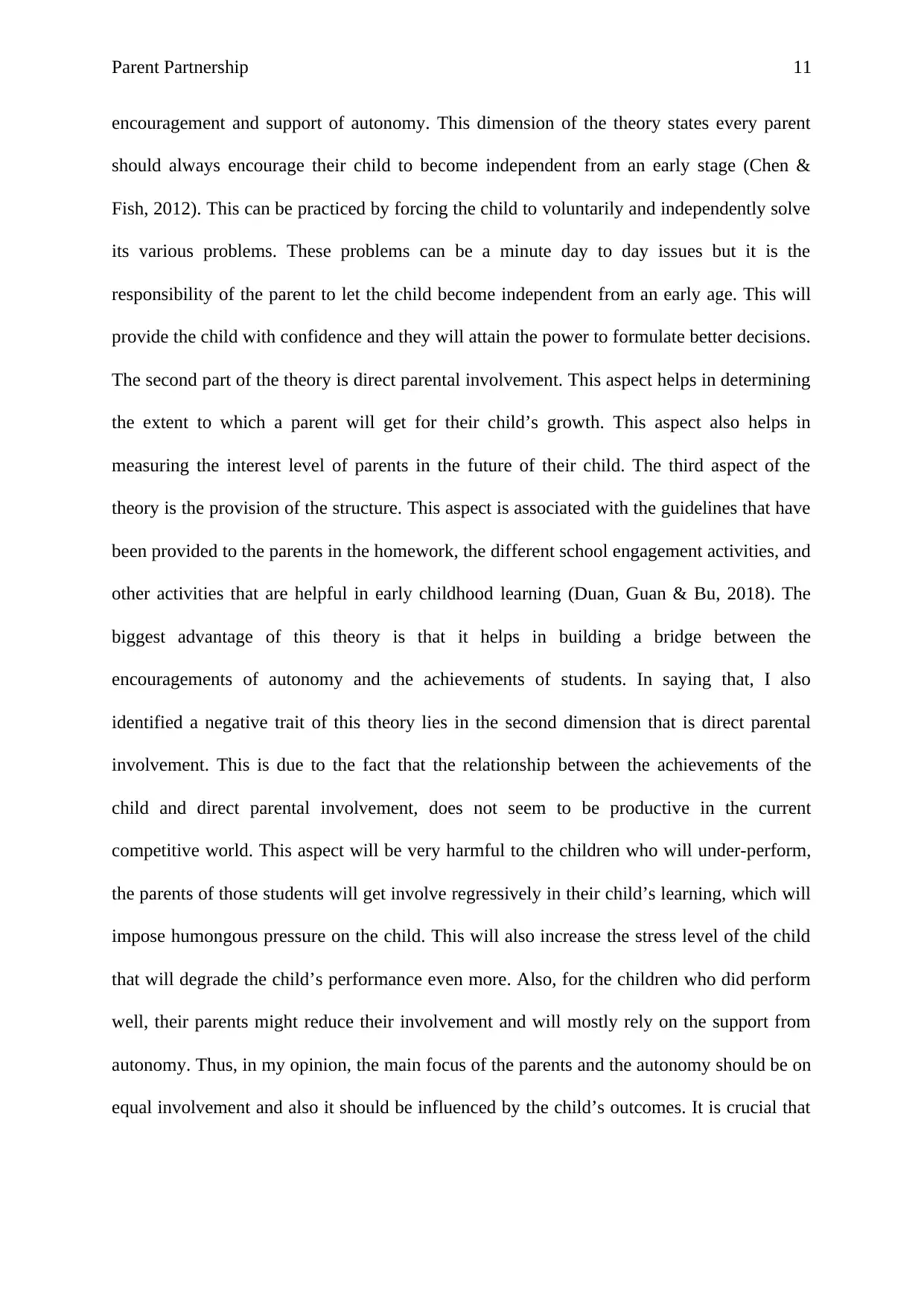
Parent Partnership 11
encouragement and support of autonomy. This dimension of the theory states every parent
should always encourage their child to become independent from an early stage (Chen &
Fish, 2012). This can be practiced by forcing the child to voluntarily and independently solve
its various problems. These problems can be a minute day to day issues but it is the
responsibility of the parent to let the child become independent from an early age. This will
provide the child with confidence and they will attain the power to formulate better decisions.
The second part of the theory is direct parental involvement. This aspect helps in determining
the extent to which a parent will get for their child’s growth. This aspect also helps in
measuring the interest level of parents in the future of their child. The third aspect of the
theory is the provision of the structure. This aspect is associated with the guidelines that have
been provided to the parents in the homework, the different school engagement activities, and
other activities that are helpful in early childhood learning (Duan, Guan & Bu, 2018). The
biggest advantage of this theory is that it helps in building a bridge between the
encouragements of autonomy and the achievements of students. In saying that, I also
identified a negative trait of this theory lies in the second dimension that is direct parental
involvement. This is due to the fact that the relationship between the achievements of the
child and direct parental involvement, does not seem to be productive in the current
competitive world. This aspect will be very harmful to the children who will under-perform,
the parents of those students will get involve regressively in their child’s learning, which will
impose humongous pressure on the child. This will also increase the stress level of the child
that will degrade the child’s performance even more. Also, for the children who did perform
well, their parents might reduce their involvement and will mostly rely on the support from
autonomy. Thus, in my opinion, the main focus of the parents and the autonomy should be on
equal involvement and also it should be influenced by the child’s outcomes. It is crucial that
encouragement and support of autonomy. This dimension of the theory states every parent
should always encourage their child to become independent from an early stage (Chen &
Fish, 2012). This can be practiced by forcing the child to voluntarily and independently solve
its various problems. These problems can be a minute day to day issues but it is the
responsibility of the parent to let the child become independent from an early age. This will
provide the child with confidence and they will attain the power to formulate better decisions.
The second part of the theory is direct parental involvement. This aspect helps in determining
the extent to which a parent will get for their child’s growth. This aspect also helps in
measuring the interest level of parents in the future of their child. The third aspect of the
theory is the provision of the structure. This aspect is associated with the guidelines that have
been provided to the parents in the homework, the different school engagement activities, and
other activities that are helpful in early childhood learning (Duan, Guan & Bu, 2018). The
biggest advantage of this theory is that it helps in building a bridge between the
encouragements of autonomy and the achievements of students. In saying that, I also
identified a negative trait of this theory lies in the second dimension that is direct parental
involvement. This is due to the fact that the relationship between the achievements of the
child and direct parental involvement, does not seem to be productive in the current
competitive world. This aspect will be very harmful to the children who will under-perform,
the parents of those students will get involve regressively in their child’s learning, which will
impose humongous pressure on the child. This will also increase the stress level of the child
that will degrade the child’s performance even more. Also, for the children who did perform
well, their parents might reduce their involvement and will mostly rely on the support from
autonomy. Thus, in my opinion, the main focus of the parents and the autonomy should be on
equal involvement and also it should be influenced by the child’s outcomes. It is crucial that
⊘ This is a preview!⊘
Do you want full access?
Subscribe today to unlock all pages.

Trusted by 1+ million students worldwide
1 out of 25
Related Documents
Your All-in-One AI-Powered Toolkit for Academic Success.
+13062052269
info@desklib.com
Available 24*7 on WhatsApp / Email
![[object Object]](/_next/static/media/star-bottom.7253800d.svg)
Unlock your academic potential
Copyright © 2020–2025 A2Z Services. All Rights Reserved. Developed and managed by ZUCOL.





